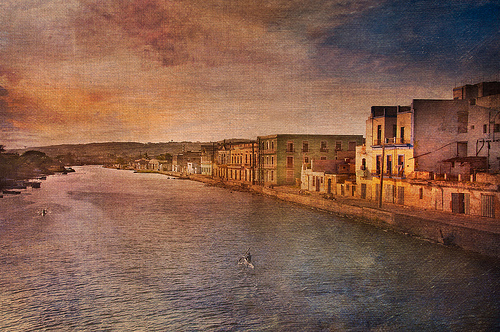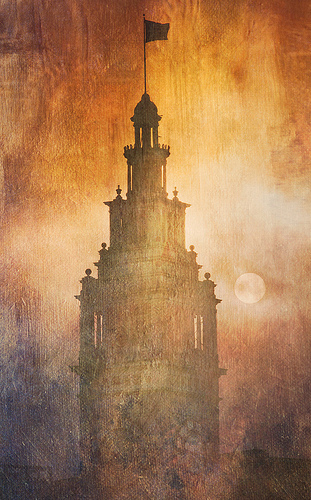It’s fun to apply textures to an existing image to create a new effect. In this context, a texture is simply a flat shot of paint on wood, or canvas, or something textural. It is applied over the original image in a Photoshop layer stack. This may seem counter-intuitive because people expect textural effects to belong to the background, as would be the case with a physical painting on canvas. In fact, some of my floral tapestries combine a scanned background of paper or canvas with textural overlays, so many variations are possible.

Most often, I’ll experiment with different blending modes and opacity to add interest to my overlay textural effect—and I usually use more than one texture overlay per image. Note that I am using the term “overlay” to simply mean the texture layer is above the image layer on the Photoshop layer stack, and I am not referring to the Photoshop Overlay Blending Mode.
I used exactly the same “recipe” with Venice of Cuba (shown above) and Tower in the Sun (below). The recipe consists of a series of specific textural layers applied at a given opacity and a variety of blending modes.
Good documentation is important—so one can repeat the steps on a new image. It’s possible to keep track of this kind of formula by taking notes, but the best kind of documentation shares a trait in common within software development—it is self-documenting. The most important aspects of self-documenting a layer-based process are to:
- Make sure the layer structure is coherent
- Name each layer so that the contents of the layer are self-evident (this corresponds to good variable naming in software development)
- Try to use each layer for a single purpose only (it’s better to copy a layer and use two layers than to try to get a layer to do “double duty”)

About the images: While Tower in the Sun appears to depict an exotic location, it was in fact shot close to my home. The tower is the Ferry Building in San Francisco. I substantially underexposed the original image at 1/2000 of a second, f/16, and ISO 200 so that the disc of the setting sun would be rendered.
Venice of Cuba shows a river in Matanzas, Cuba. Matanzas is sometimes called the “Venice of Cuba”—hence the title of this interpretation. My thought in creating the “recipe” was to try for an effect like a Canaletto painting. You can view the original photo that the texturized version was made from on my blog.
JTasoff
6 Aug 2012Beautiful photographs reminiscent of many of the Dutch painters in the 17th century, such as Jacob Isaakszoon van Ruisdael in “Tower Mill at Wijk bij Duurstede, Netherlands,” 1670.
Pingback: Storm in Upper New York Bay
Pingback: Ice-Nine